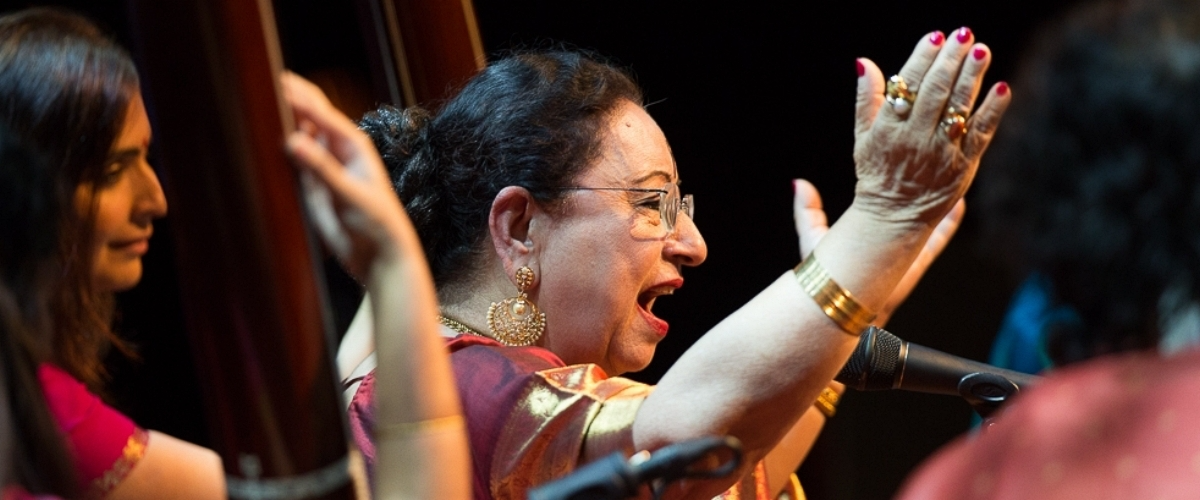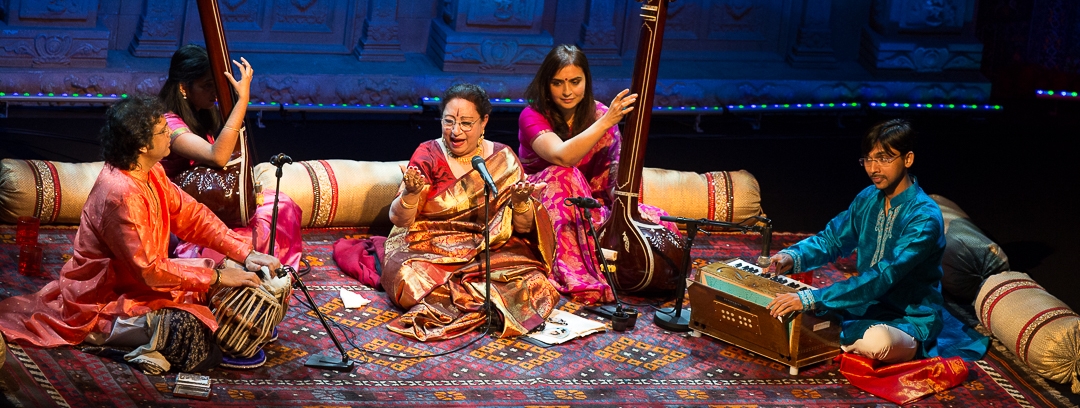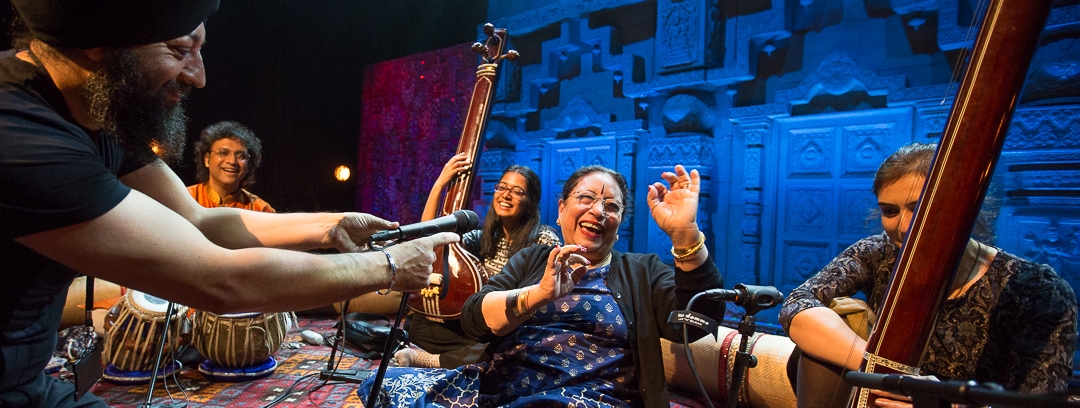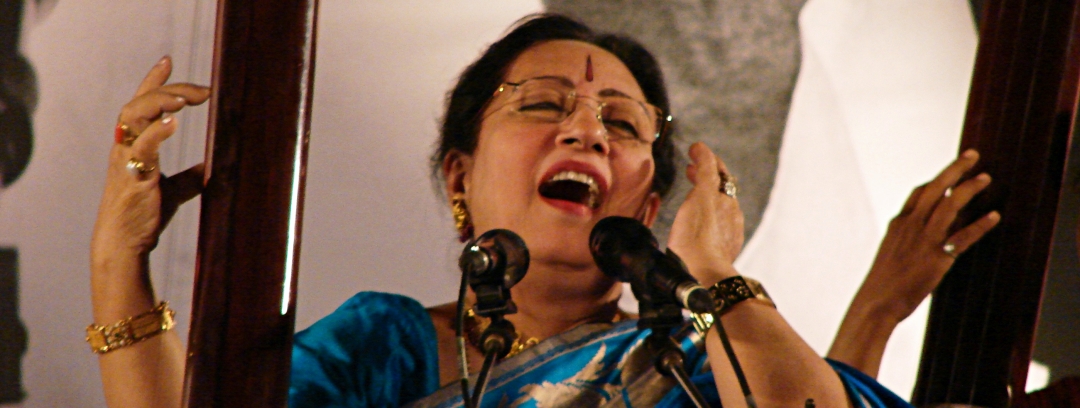

The Patiala khayal superstar discusses her unique cultural heritage, the power of physical expression, and how to lose yourself in the divine.
—Part of Living Traditions: 21 articles for 21st-century Indian classical music
Begum Parveen Sultana’s breathtaking voice is famed for its range, clarity, and versatility. Spanning nearly four octaves, she can swoop from patient meditations to powerful evocations of the divine in an instant. Equally at home with classical khayal, devotional bhajan, and poetic thumri, she is a modern Hindustani superstar.
Born into an Assamese family of Afghan heritage, she started developing her unique style from early childhood. Aged five her mother noticed her talent for humming along to her father’s practice, and soon after he began instructing her in his own Patiala gharana (regional style). She imbibed the sounds of Lata Mangeshkar along with the classical greats, and made her public debut aged twelve.
Later she studied under renowned scholar-musician Chinmoy Lahiri, famous for bringing together the ideas of nine gharanas. At Lahiri’s home one day she met Kirana gharana vocalist Ustad Dilshad Khan. The pair would go on to study together, marry, and tour the world performing jugalbandi vocal duets, intertwining their own gharanas with other styles from across North India.
Sultana has always prioritised classical music (“the sadhana of it, the pleasure of it, the godliness of it, it can’t be replaced by anything”), but is famous for excursions into filmi too. Khayya, a veteran film composer, has written for her: “If it’s tough, she’s the one to ask - she’ll deliver it like it’s the easiest thing you’ve created”.
She has received acclaim from the establishment’s highest echelons for the directness of her approach, at age 26 becoming the youngest ever artist to receive the Padma Shri (India’s fourth-highest civilian award). She has since been recognised by institutions from the Sangeet Natak Academy to MTV, as well as being awarded titles such as ‘Cleopatra of Music’.
Sultana lit up London’s Barbican Centre in October 2018 to close Darbar Festival, accompanied by Mukundraj Deo’s tabla and Tanmay Deochake’s harmonium. Darbar interviewed her on two occasions around the time of the concert - Sandeep Virdee (our Artistic Director) spoke to her beforehand, and I did so afterwards. Below are some collated highlights from our discussions, covering her family history, the diffusion of the gharana system, and her own multitude of influences.
Your family has a mixed religious heritage. Do you think that having a specific faith is less important than pursuing a direct connection to the divine?
I don't mix up my music with my religion - music is already divine and religious to me. I was brought up this way by my parents, who were progressive Muslims. There was always space to express yourself in the family - the women often wore garments associated with Hinduism, and I still do this now.
My husband is a [Muslim] Ustad, and I have been bestowed with the title Begum [a Muslim woman of great accomplishment]. But my first guru was a [Hindu] Pandit, and I sing songs to Hindu goddesses such as Shakti. My music must always directly connect the individual self with the divine, and the divine does not, I believe, recognise such boundaries as these.
Tell me more about the history of your family...
My grandfather was a timber merchant. He came from Iran originally, and settled in Assam because the area was famous for timber and ivory - he used to be one of the main businessmen in these trades. He had six daughters and one son, and used to play the flute and the rabaab [an Afghan sarod-like lute]. He loved Indian classical music but didn’t know so much about it.
I think my father got the gift from him, as he also became fanatical about the music. When the family settled down, my grandfather sent him to Kolkata for school and higher study. He met many musicians - in every house there you will find somebody singing. Afterwards he also became a timber businessman, but pursued music too. He met great Pandits and became good friends with them. And being a moneyed person, he always had many musicians coming to him!
Finally he came to Bade Ghulam Ali Khan [the legendary Patiala gharana vocalist]. The status he had...if he coughed, people would say ‘waah...’! My father went to learn from him for a little while, but unfortunately the great master died soon after. Similarly, his sisters - my aunties - were also very talented singers, not professional but very good. Music was always in the air.
What were your first experiences with singing and music?
Our house was full of music 24 hours a day. My father would always play old gramophone records, telling my mother “listen to this”. Once, when I was four years of age, he was composing something on harmonium. He had to go away for a little time, just five or ten minutes. When he came back he found I was trying to copy the melody.
So he said, “Are you interested in playing the harmonium?”. I said, “No, I want to sing. Teach me baba’. And later on he said, “OK - we will begin with these two melodies”, and it all started like that. Also I would also sit with him all the time and listen to records. When you love the subject, you are automatically into it. You can say I became completely gone to that world. Like his own father, he gave me that gift.
How did your father go about teaching you as a child?
We were very close. My fondest memories of him are of singing ‘aa-ka’. We would practice bandishes [composed melodies], taans [fast melodic elaborations], gamakas [oscillation between two notes] using only these syllables. No ‘ee’, no ‘en’, no other alphabet. Only ‘aah-ka’ - this makes it all very difficult!
He also told me, ‘In the granth [holy books] of music it is written: think first of your presentation. Whether a girl, boy, man, or woman, you have to appear very nicely on stage - well behaved, well mannered, and so on. The rest is your music, which must be divine and melodious. My father was very strict with this. He used to tell me the expression must come from your face too, and gave me a big mirror. This was very important.

"Directly connect the individual self with the divine..." Photo: Rehmat Rayatt
Later you studied with other gurus. How did this come about?
One day my father called me to speak to him. I was hardly 5 and a half. He said, “Soon, I won’t know what to do with you. You are very intelligent - any line, any raga you can sing. I’ve only given you some paltas [vocal exercises], but you’re doing them so nicely, so full of your soul”. I was so shocked, and remember thinking, “This is god's signal to me, and I have no right to stop”.
And when I was something like 7 years of age, he said, ‘Whatever I can do, I have done for you. But I am not a great master like others. From here I want you to go to a good Ustad who will show you the path. The music is an ocean - or rather seven or eight oceans - and you must be able to swim. So I would like to take you to Calcutta to find a teacher. Will you come with me?”.
I said “yes” immediately, like I was jumping into this ocean! But my father had problems finding an Ustad who would accept a female student. Nowadays things such as gender don't count as much, but back then they did, and it took almost two months to find a guru.
When we arrived there he would tell people, “I don’t just want a musician. I want a proper guru, who will teach the music and the theory - both, side by side”. To have parents who will understand like this...without this you can’t do anything. And I’m so grateful to god that he gifted me this art. Not only that - there were no problems for me on my path. I had nothing but good luck.
How did you find life in Kolkata back then?
When I arrived I was so excited, thinking, “Wow, I can learn music here - I can learn to sing!”. It was like a temple for me. I remember looking at old, old artist photographs in the houses, and seeing the tanpuras lying all around. The people I met there were god-fearing, kind people. They love to give, always saying “come on, take from me!”.
Eventually you entered long-term study with the renowned scholar-musician Pandit Chinmoy Lahiri. What was his approach to training like?
He learned with gurus from nine different gharanas - Agra, Gwalior, Jaipur, Delhi, Patiala, and others. His dedication was incredible. When we began, he told me, “I don’t have a daughter. Today, I take you in as my daughter”. I learned from him for almost six to seven years, going to his house every Friday and Saturday. He taught me very nicely.
Along with my lessons guru-ji would tell me to listen to some lovely music - Alauddin Khan, Vilayat Khan, and Ravi Shankar. He would tell my father how important it was to listen, so my father would lock me in a room with the gramophone and afterwards give me some toffees or chocolates! But he didn’t have to tell me to practice. I had made my plan, and told my mind: “I have to take this line...I want to be a good singer”.
How did you go about learning the ragas? What does the concept of raga mean to you?
There is confusion and controversy about defining many ragas, when they share an ascending scale, or a descending, or some other shapes. This is the fault of some gurus who do not teach the ragas properly. A good guru - such as my own - will always say, “Let’s see, this raga you’re singing now. It is similar to this other raga. They might come together, so you must be careful to separate them”. And they will show you how.
So to learn one raga you must know another five along with it, to really know the differences. It is not just ‘Sa, Re, Ga’, and so forth. It is like a game of hide-and-seek. In this way you can say each raga is a mirror of all Hindustani music.
What was life outside music like for you back then?
I was having a good time, giggling around, with lots of good food. I loved ornaments and dressing up, but didn’t even know how to properly wear the sari on some of the record covers! I could always get involved with learning any subject. I get so into it I forget the world. That is the gift of god.
My parents didn’t really say, “Don’t do this, don’t do that”. My father had faith in me, as he had brought me up that way. But I was still a girl then, of just 18 or 19, and very beautiful to look at (...well this is what people said, I don’t know!). I was thinking, “These great, great musicians - why are they after me? They are very much older than me!”.
My parents used to talk to me, saying “The music world is both good and bad. If you’re strict with yourself then they won’t come near you, but if you flatter them then everyone will start coming to you. You must be careful.”.

"It is like a game of hide-and-seek..." Photo: Rehmat Rayatt
Guru-ji later became very sick. He had high blood sugar and gout, but I was too young to understand these things. Inside he was thinking, “After me, who will take care of her teaching? Who will look after the music?” He discussed with my father, who said, “God will help us. Something will come”.
And then one day, guru-ji came to my father and said, “I have a young fellow, from a very well-to-do, cultural family, all musicians. He’s a very good singer, learning from a great guru of Kirana - an old, tough, traditional gharana. He’s an engineer too, with many degrees and some years in London. Perhaps he can teach”. My father said “OK, I will talk to him”. So then Dilshad-ji comes, and I meet him for the first time at my guru’s house.
He soon became my teacher, and later my husband. We were always both very, very religious. And what is our religion? Music. Dilshad-ji has taught me so much. We still discuss the workings of the ragas, and by now he has become the khalifa [leader] of his Kirana gharana. I’m so grateful to god to have someone like him as a life partner. He has some of my father’s nature.
Since then you have enjoyed a stellar performance career. How do you approach live performance?
I’m not an Ustad or a Pandit. I’m a performer - this is my identity. So I will try to sing my best for you, always giving 100%. I make it easy for the audience. I look at each and every person sitting in the hall, and within no time I know their modes and see what they want. And I sing accordingly.
Like my guru-ji, I use the sounds of many different gharanas. A good connoisseur can immediately make out what turn I'm taking, where I’m taking off and landing. They know when I’m sitting in Patiala gharana, when I’m going to Kirana, and so on.
But I have to capture the whole of my audience, even the gallery. I should give respect to them all, as they're spending money and time to listen to me. Whether khayal, bhajan, thumri, or tarana, you must do this. If there’s a good, appreciative audience, I can live for them.
You must balance its demands of with your own personality, and I always seek to develop my identity through personal efforts and my own research. But I do not break the rules of our pure classical music. The core ideas are ancient, and we must keep them intact - there are reasons they have lasted so long.
Have you been drawn to much non-Indian music?
I listen to many Western classical musicians - composers such as Bach, Beethoven, and Mozart, and performers such as [pianist] Vladimir Horowitz. Musicians should open their ears to many different ideas. I believe the personal creative impulse is more important than trying to limit yourself to your own tradition.

"Musicians should open their ears to many different ideas."
You speak of “the godliness, the sadhana” of classical music. What does sadhana mean to you?
I have been practicing sadhana for over 60 years now. Sadhana is about finding courage. It means having full concentration. You are thinking about god, about receiving health, intelligence, and a good voice. You say “Help me god, help me while I am practicing, help when I am composing. I must have my own identity - but please help me to find it”.
Your riyaz [immersive practice] must be sadhana. But it is not only about raag singing. It is like meditation really. When I’m doing my riyaz I don’t know where I am. This way, when on the stage audiences will say, “You’re in a different world, and you’re taking us with you”. It is very difficult to come down to reality again. I need at least 15, 20 minutes after a performance. Then, I can speak again.
What advice would you give to young classical singers today?
The younger generation are singing very well, but sometimes they want to become famous in no time. You must have patience. And do not feel jealousy. Instead, get strength from god. When you’re singing through your soul, that is what we call pure music. Maybe you can channel Shakti [the divine feminine] - women are Shakti anyway, so we don’t have to work so much to produce extra!
You must think very hard when in your riyaz - of all the movements, how much mouth to open, and so forth. Be aware of the flex of your vocal cords for different volumes. You have to measure it even, saying, “this is the volume, this is the movement”.
Try to sing in all octaves. Many students do not, just because nobody told them to do that riyaz. You should sing low too! I always sing full-throated, never in falsetto. But remember the vocal cords are very delicate. [Parveen sings a pitch-perfect low A2 tone - a note which lies near the bottom of the male tenor range].
Above all I will always remember what my guru-ji told me. He said the audience are not fools, and that you should not bluff them. And you should not bluff yourself either. So in the end you must enjoy doing it. If you don’t love music it will never come to you. Beyond what you can control, success is in the hands of god.
Are you optimistic about the future of Hindustani classical music? What should younger musicians bear in mind to help strengthen the tradition?
The old world is disappearing, and I’ve seen people change with it. But the music not so much. It is still very beautiful, very divine. I actually think that it is improving at the moment. I can feel it around me - so many young people are taking a great interest.
Different musicians should bear different things in mind, but to keep the tradition strong you must focus on the core ways we have always learned it. This means you have to have dedication, hard work, and a proper guru. We must all fight for the real classical music - I want to take it into everyone’s drawing room.
Why am I am optimistic about the future? Because if you do music then it feels like your depression will go, and you’ll be a wonderful human being who does not wish to do anybody wrong. Singing is my prayer. I don’t know to whom I am praying - but music is the shortest road to them, to the oneness that is god.
• George Howlett is a London-based musician and writer, specialising in jazz, rhythm, Indian classical, and global improvised music. Article also features material from Sandeep Virdee's conversation with Parveen.
Darbar believes in the power of Indian classical music to stir, thrill, and inspire. Explore our YouTube channel, or subscribe to the Darbar Concert Hall to watch extended festival performances, talk and documentaries in pristine HD and UHD quality.
It's like the rush of a marsh on a midsummer night with a million crickets, or the howling wind stirring and the...
Read More 
The Benares tabla maestro discusses jazz, turning down the Sugababes, and the links between rhythm and food. By...
Read More 
Khayal is now the most dominant form of North Indian classical vocal music. The word (also spelt khyal) comes from...
Read More 
The beginner's guide to Indian classical music. Whether you’re completely new to raga music or just need a refresher, we’ve put together this brief overview of all things raga music to help you feel at ease when visiting one of our concerts or watch our videos on our YouTube or our Darbar Concert Hall.
Keep up to date with the latest news, events, music and musings across our social channels
For hundreds more clips and shorts, vist our YT page here 